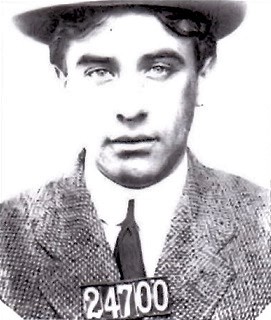
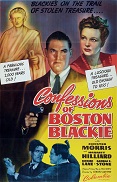 Boston Blackie (1944, 1945-1950) aired “The Skating Rink Murders” on July 9, 1946 as the 65th broadcast of the estimated 220 from its 1945-1950 run. This is but the fourth episode of Boston Blackie we have featured, the last coming in June of 2021, and is only the third since 2019; so for newcomers I recap below the rather fascinating history of the man behind the stories that eventually led to Boston Blackie coming to radio, film, and even early television. The show was produced originally in 1944 as a 13-episode summer replacement for the Amos & Andy Show. It proved popular enough and aired its first show in April of 1945, but under different ownership (ZIV productions, running on NBC in its own time slot), format, and actors. Chester Morris played Boston Blackie while Richard Lane played the part of Inspector Farraday in the 1944 replacement episodes, though in its official 1945 incarnation Richard Kollmar (1910-1971, photo middle right) became Boston Blackie, primarily due to contractual film obligations that stood in the way of Chester Morris continuing the role.
Boston Blackie (1944, 1945-1950) aired “The Skating Rink Murders” on July 9, 1946 as the 65th broadcast of the estimated 220 from its 1945-1950 run. This is but the fourth episode of Boston Blackie we have featured, the last coming in June of 2021, and is only the third since 2019; so for newcomers I recap below the rather fascinating history of the man behind the stories that eventually led to Boston Blackie coming to radio, film, and even early television. The show was produced originally in 1944 as a 13-episode summer replacement for the Amos & Andy Show. It proved popular enough and aired its first show in April of 1945, but under different ownership (ZIV productions, running on NBC in its own time slot), format, and actors. Chester Morris played Boston Blackie while Richard Lane played the part of Inspector Farraday in the 1944 replacement episodes, though in its official 1945 incarnation Richard Kollmar (1910-1971, photo middle right) became Boston Blackie, primarily due to contractual film obligations that stood in the way of Chester Morris continuing the role.
The Boston Blackie character first appeared in a series of short stories, the first in 1914 in The American Magazine by author Jack Boyle (1881-1928, photo top right). Boyle led a short but colorful life, spending two stints in prison for passing bad checks and forgery. Details of his life between the years 1908 and 1914, according to this website, are scarce, though through diligent research and some luck it was discovered that Boyle spent 10 months in San Quentin (mug shot top right) beginning on December 17, 1910 and was released the following October; though a few years later in 1914 he would be serving another stint in the joint, this time in a Colorado state prison for much the same offenses.
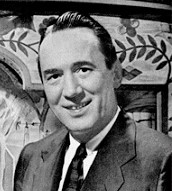
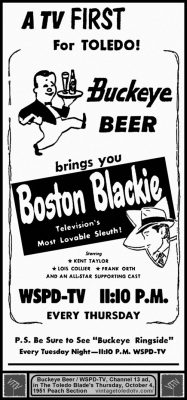 Turning what he knew into what he would write, Boyle then created the fictional character of Boston Blackie, a reformed jewel thief and safe-cracker who had done prison time and was now an “Enemy to those who make him an enemy. Friend to those who have no friend.” Blackie is aided in his capers by his rather slow-witted sidekick Runt, and is hounded by police Inspector Farraday (the police inspector working against, or trying to pin the blame for crimes against the hero being a popular formula that became a staple, i.e. The Shadow, Rocky Jordan, The Green Hornet, and many others in print, radio, and film). Boyle’s stories hit the right chord and a whopping 11 silent films featuring Blackie were made from 1918-1927. The series was picked up in 1941 with Chester Morris in the lead as Blackie in Meet Boston Blackie, the first of what would be 14 total films, the final one to hit the silver screen in 1949 and all starring Chester Morris. When the new medium of television became all the rage Boston Blackie was among the first to jump on board with Boston Blackie. It debuted in 1951, ran for 58 half-hour episodes until 1953, and would then air in syndication for almost another ten years. An interesting side note is that of Blackie’s 58 TV shows 32 were shot in color, while the remaining 26 were shot in black & white, shooting in color something unheard of at the time (and expensive) for an early television show. But the producers were ahead of their time and gambled that when color became more widely available there would be a market for color reruns. Thus, Boston Blackie would join the ranks of the few early TV shows also shot at least in part in color, Superman and The Cisco Kid two favorites coming to mind.
Turning what he knew into what he would write, Boyle then created the fictional character of Boston Blackie, a reformed jewel thief and safe-cracker who had done prison time and was now an “Enemy to those who make him an enemy. Friend to those who have no friend.” Blackie is aided in his capers by his rather slow-witted sidekick Runt, and is hounded by police Inspector Farraday (the police inspector working against, or trying to pin the blame for crimes against the hero being a popular formula that became a staple, i.e. The Shadow, Rocky Jordan, The Green Hornet, and many others in print, radio, and film). Boyle’s stories hit the right chord and a whopping 11 silent films featuring Blackie were made from 1918-1927. The series was picked up in 1941 with Chester Morris in the lead as Blackie in Meet Boston Blackie, the first of what would be 14 total films, the final one to hit the silver screen in 1949 and all starring Chester Morris. When the new medium of television became all the rage Boston Blackie was among the first to jump on board with Boston Blackie. It debuted in 1951, ran for 58 half-hour episodes until 1953, and would then air in syndication for almost another ten years. An interesting side note is that of Blackie’s 58 TV shows 32 were shot in color, while the remaining 26 were shot in black & white, shooting in color something unheard of at the time (and expensive) for an early television show. But the producers were ahead of their time and gambled that when color became more widely available there would be a market for color reruns. Thus, Boston Blackie would join the ranks of the few early TV shows also shot at least in part in color, Superman and The Cisco Kid two favorites coming to mind.
“The Skating Rink Murders” begins, oddly enough, with Blackie and friend Mary getting some exercise at a skating rink, a popular entertainment venue throughout the 1940s. (In fact, from approximately 1937–1959 roller skating was the number one participatory sport in America, and this time period was considered the Golden Age of roller skating.) When a scream from outside the rink cuts Blackie’s and Mary’s fun short they rush to investigate and find a young woman choked to death and wearing an obviously expensive diamond ring. Ruling out robbery because the ring was not taken, Blackie visits the police to find out what they know—if anything. The only fact passed on to him by the cops is that a man professing to be her husband has claimed the body. We soon discover that this is not the case when the supposed husband is found dead and the woman he claimed is his wife is gone (again with the expensive diamond ring). So what is going on here? We have two dead people, a dead (and now missing) woman wearing an expensive diamond ring no one seems to want, and one or more killers on the loose. How it all comes together is a mystery indeed, a crazy quilt of mismatched clues and just the sort of dangerous puzzle worthy of Boston Blackie as he sets out to solve “The Skating Rink Murders.”
Play Time: 29:47
{This episode of Boston Blackie aired on a Tuesday evening at 7:30 PM, still early enough for youngsters to enjoy before they were shooed off to bed. Still, it was the middle of summer and with no school the next day the neighborhood gang met at the nearby newsstand to recapture the thrill of danger from various magazines they knew awaited them there. Astounding SF (1930-present, now Analog) was a perennial favorite, with its own take on adventure and danger in possible futures. It was a monthly in 1946. Doc Savage (1933-1949) guaranteed a thrill a minute against all manner of evil, the cover below perfect evidence of 15 cents well spent. Doc Savage was a monthly in 1946. Famous Fantastic Mysteries (1939-1953) reprinted many classic fantasy tales from the past, stories that often pulled readers into the shadows of the dark side for stories of the supernatural, literary journeys drawn by masters of the genre featuring untold evils beyond anything young imaginations could conceive. It was a hit and lasted a respectable 14 years. It was a bi-monthly in 1946.}
[Left: Astounding, 7/46 – Center: Doc Savage, 7/46 – Right: Famous Fantastic Mysteries, 6/46]
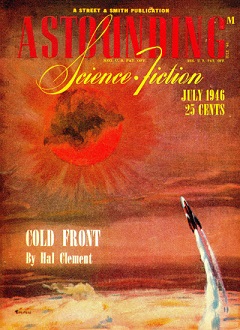
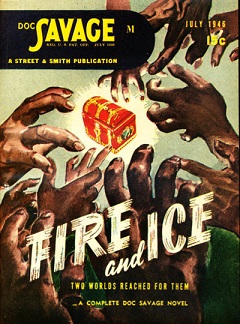
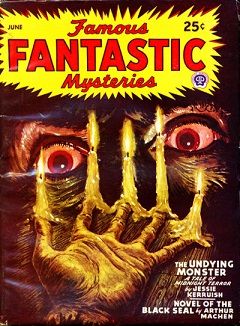
To view the entire list of weekly Old Time Radio episodes at Tangent Online, click here.